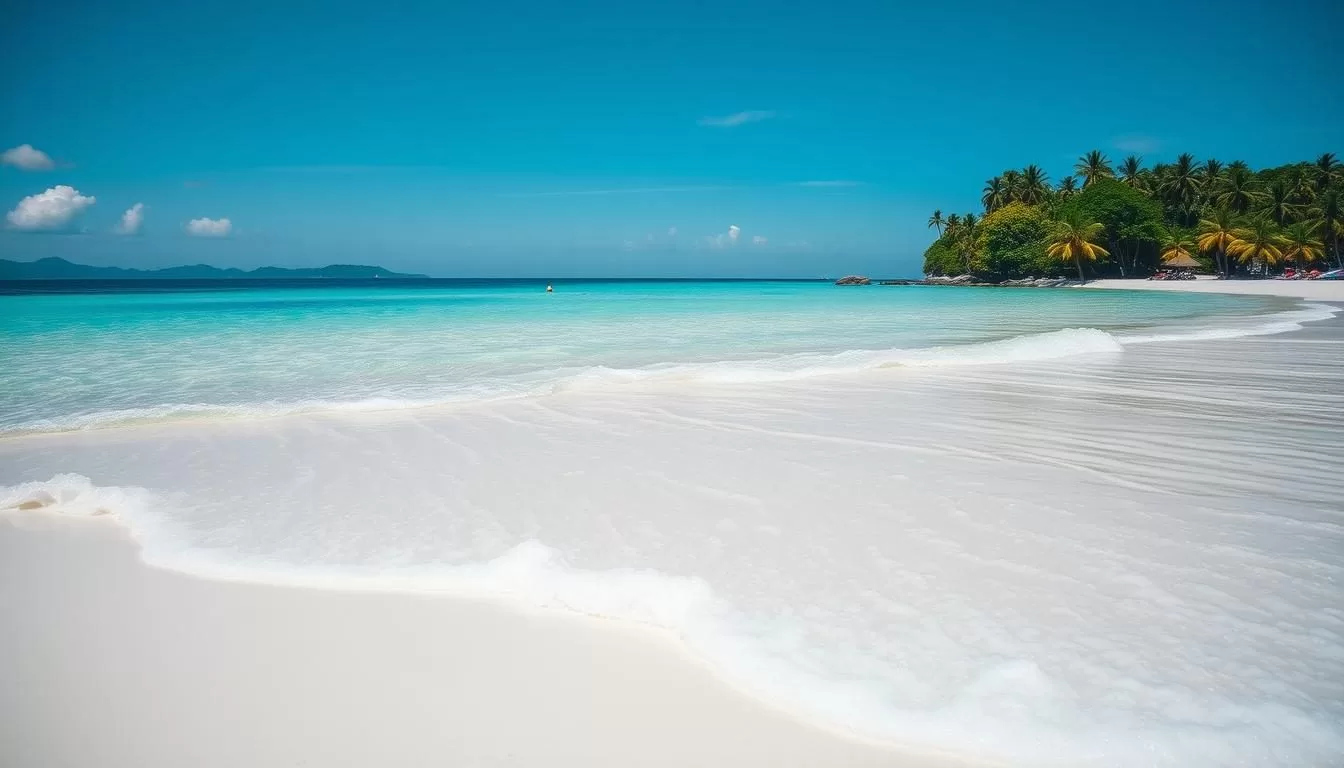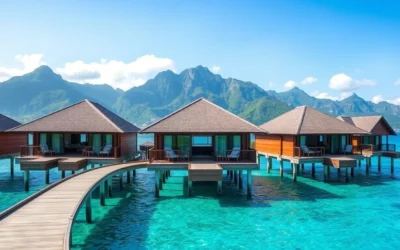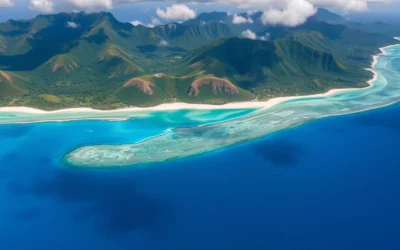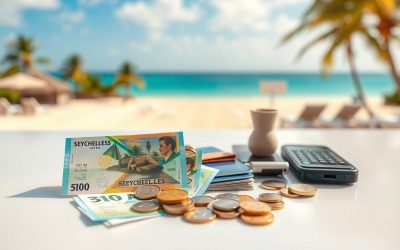✓ Accommodations ✓ Flights ✓ Rental Cars ✓ Tours & Activities
Approximately 930 miles off the eastern coast of Africa, the Seychelles islands present a picturesque getaway with their white-sand beaches and lush landscapes. The Seychelles archipelago, comprising 115 islands, is a tropical paradise that offers a unique vacation experience.
Introduction to Seychelles
The Seychelles is considered a paradise destination due to its pristine beaches, crystal-clear waters, and unique wildlife. The islands are beautiful year-round, but the best time to visit is during the spring or fall when the weather is nearly perfect and the crowds are smaller.
Understanding the climate patterns of Seychelles is crucial for planning a weather-savvy trip. The geographical location of Seychelles in the Indian Ocean significantly influences its weather throughout the year.
Why Timing Matters
Timing your visit to Seychelles is essential for the perfect vacation experience. The archipelago’s weather patterns make certain months more favorable than others for different types of travelers and activities.
The two main seasons and trade wind patterns play a significant role in shaping the weather conditions across the islands. By understanding these factors, you can plan your trip to enjoy activities like beach relaxation, scuba diving, hiking, and wildlife viewing to the fullest.
Whether you’re looking for a relaxing getaway or an adventure-filled vacation, Seychelles has something to offer. With its diverse landscapes and climates, the islands cater to various preferences, making it a versatile destination for travelers.
Understanding Seychelles’ Unique Climate
With its islands situated near the equator, Seychelles has a relatively consistent climate throughout the year. This consistency is a hallmark of the archipelago’s weather patterns.
Geographical Location and Its Impact on Weather
The Seychelles’ geographical location in the Indian Ocean significantly influences its climate. The islands’ proximity to the equator means they receive a substantial amount of sunlight throughout the year, contributing to their warm temperatures. The ocean surrounding the islands also plays a crucial role in moderating the climate, keeping temperatures relatively stable.
Year-Round Temperature Patterns
The warmest time of the year in Seychelles runs from December to April, with temperatures remaining fairly steady throughout the year. Temperatures rarely drop below 75°F or exceed 90°F, making the climate pleasant. The humidity levels can affect the perceived temperature on different islands, but cool ocean breezes help maintain comfortable conditions even during the warmest month.
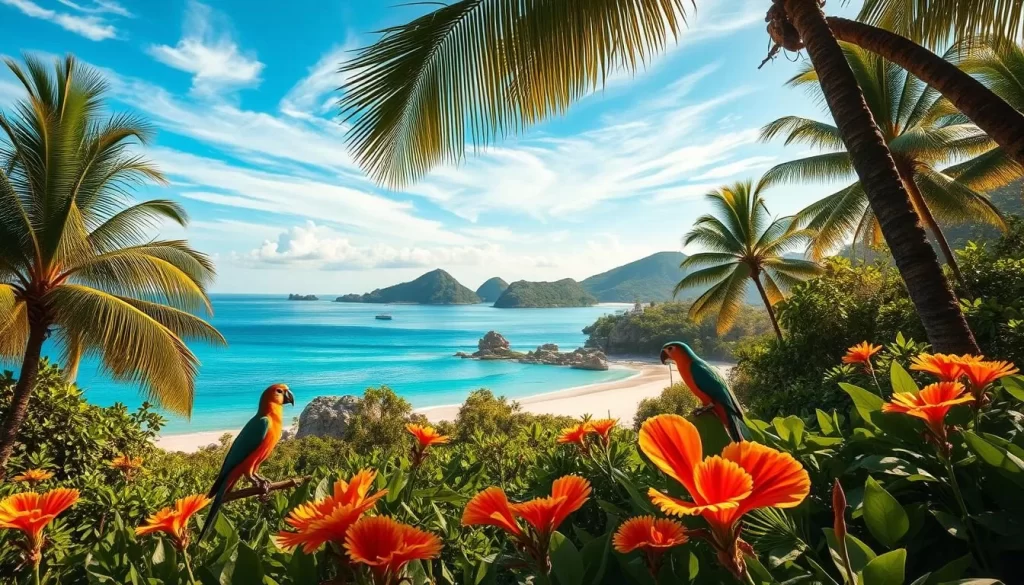
The Two Seasons of Seychelles
Understanding the two seasons of Seychelles is crucial for planning a trip that makes the most of the weather. Seychelles, being a tropical archipelago, has a climate that is characterized by two distinct seasons.
Dry Season: May to October
The dry season in Seychelles, spanning from May to October, is marked by pleasant weather with minimal rainfall. During this period, the islands experience a gentle breeze, courtesy of the southeast trade winds, making it ideal for outdoor activities such as sailing and diving. The dry season is considered the best time of the year to visit Seychelles, with comfortable temperatures and plenty of sunshine.
Rainy Season: November to April
The rainy season, which runs from November to April, brings a different experience to Seychelles. Although it’s characterized by rainy season showers and higher humidity, the rain typically comes in short, intense afternoon showers rather than all-day downpours. January and February are usually the wettest months. Despite the rain, the islands remain warm and sunny, making it still a great time to enjoy beach activities. The increased rainfall results in lush landscapes, and visitors can enjoy fewer tourists and potentially lower prices.
Trade Winds and Their Influence
Understanding the trade winds is essential for travelers to Seychelles, as they affect the weather and overall experience on the islands. The trade winds play a crucial role in shaping the climate of Seychelles, bringing different conditions during various parts of the year.
Northwest Trade Winds (November-March)
From November to March, the northwest trade winds dominate the Seychelles archipelago. These winds bring warm, humid air, contributing to the rainy season during this period. The northwest trade winds can lead to more unpredictable weather, with increased chances of rain and higher humidity. Travelers should be prepared for these conditions when visiting during these months.
Southeast Trade Winds (May-October)
Meanwhile, from May to October, the winds shift to the southeast, bringing cooler temperatures throughout this period. The southeast trade winds have a significant impact on the islands, resulting in:
- Cooler, drier air that makes the dry season more comfortable for tourists.
- Stronger breezes that create more dynamic sea conditions, especially on the southeastern coasts.
- A phenomenon where large amounts of seaweed are deposited along some beaches, affecting certain areas.
- Ideal conditions for wind sports such as sailing, windsurfing, and kiteboarding.
To minimize the impact of these winds on your vacation, it’s essential to plan your island and beach selection carefully. Some beaches are more prone to seaweed during this time, while others remain unaffected.
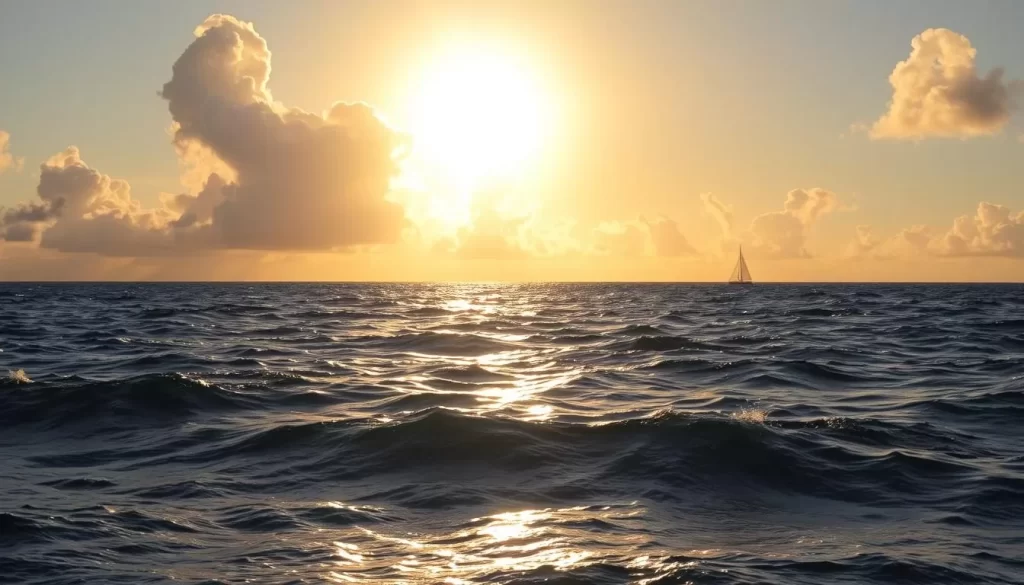
Seychelles: Best Months for a Weather-Savvy Trip
If you’re looking for the ideal time to visit Seychelles, consider the shoulder season for an optimal blend of weather and tranquility. The archipelago’s unique climate means that certain periods offer more favorable conditions for exploration and relaxation.
April-May: Perfect Shoulder Season
The months of April and May are characterized by comfortable temperatures and lower humidity, making them ideal for exploring the islands. The warmer weather of the preceding months has just passed, resulting in extremely comfortable conditions. You’ll find that the beaches, restaurants, and other attractions are less crowded during this period, allowing for a more serene experience. Visiting Seychelles during April and May means you can enjoy the islands without the peak season crowds.
October-November: Ideal Weather Conditions
Similarly, October and November offer ideal weather conditions for a visit to Seychelles. These months mark a transition period before the onset of the rainy season, with warm temperatures and lower humidity. The result is a pleasant climate that’s perfect for outdoor activities and exploring the marine life. Additionally, this period coincides with the whale shark season, making it an attractive time for those interested in unique marine experiences
During both these shoulder seasons, you can expect a more relaxed atmosphere, with fewer tourists and potentially lower prices. This makes April-May and October-November the best time to visit Seychelles for travelers seeking a balance of good weather, fewer crowds, and value for money.
When to Visit for Water Activities
The best time to enjoy water activities in Seychelles depends on what you’re looking for. Whether you’re interested in scuba diving, snorkeling, or swimming with whale sharks, understanding the optimal time for your preferred activity can make a significant difference in your experience.
Best Months for Scuba Diving and Visibility
For scuba diving enthusiasts, Seychelles offers incredible underwater experiences throughout the year. However, the best visibility is typically during the dry season, from April to May and September to November. During these periods, the waters are calm, and visibility can reach up to 40 meters, making it ideal for exploring the rich marine life and coral reefs.
| Month | Visibility (meters) | Water Conditions |
|---|---|---|
| April | 30-40 | Calm |
| May | 30-40 | Calm |
| September | 30-40 | Calm |
| November | 30-40 | Moderate |
Whale Shark Season
If swimming with whale sharks is on your bucket list, plan your trip between September and November. During this time, the waters around Seychelles are a haven for these gentle giants, offering a unique opportunity to interact with them in their natural habitat. The ecological factors that attract whale sharks to Seychelles during this period include the abundance of plankton and the warm waters.

Beach Conditions Throughout the Year
Understanding beach conditions in Seychelles is crucial for planning a perfect trip, as they fluctuate with the seasons. The archipelago’s beaches are known for their pristine beauty, but factors like seaweed and weather patterns can affect their condition.
Seaweed Season and Beach Selection
During certain times of the year, some beaches in Seychelles may experience seaweed influx, affecting their appeal. La Digue’s beaches, for instance, can be affected by seaweed, particularly during the rainy season. However, other beaches like those on Fregate Island remain pristine due to their unique geography and conservation efforts. Knowing which beaches to choose during seaweed season can make a significant difference in your beach experience.
Best Islands for Each Season
Different islands in Seychelles offer the best beach experiences during different seasons. For example, in February, islands like Fregate, Denis, Praslin, and Mahé are ideal for enjoying creole food, spotting black parrots, and engaging in snorkelling and scuba diving, despite occasional afternoon rain showers. Understanding the seasonal characteristics of each island helps in planning an island-hopping itinerary that maximizes good weather and beach conditions throughout your stay.
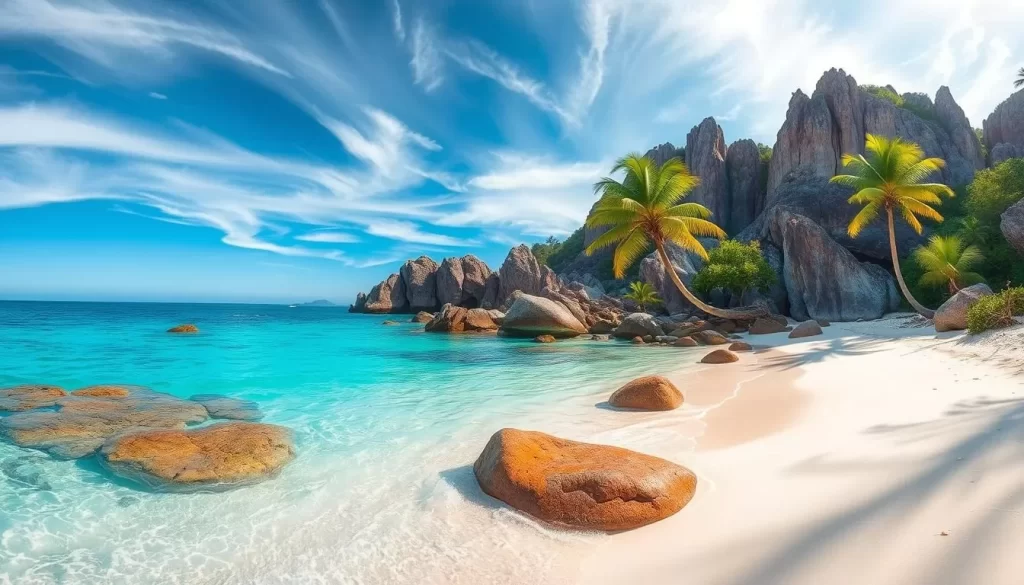
Hiking and Land Activities: Optimal Timing
To make the most of your Seychelles trip, understanding the optimal timing for hiking and land activities is essential. The archipelago’s diverse landscapes offer a range of outdoor experiences that vary significantly with the seasons.
Cooler Months for Trail Exploration
The cooler months, from May to October, are ideal for hiking and exploring Seychelles’ trails. During this period, the weather is drier and more pleasant, making it perfect for outdoor activities. The Southeast trade winds bring a cooling effect, especially in the mornings and evenings, ideal for hiking.
Wildlife Viewing Opportunities by Season
Seychelles is renowned for its unique wildlife, and the timing of your visit can coincide with spectacular events. For instance, the turtle hatching season from January to March is a highlight, where you can witness hatchlings making their way to the ocean. Other wildlife viewing opportunities include spotting rare bird species and marine creatures like dolphins and rays.
| Season | Wildlife Viewing Opportunities |
|---|---|
| January to March | Turtle hatching season |
| April to October | Bird watching, including rare endemic species |
| Throughout the year | Spotting dolphins, rays, and reef fish |
Month-by-Month Weather Guide
A month-by-month guide to Seychelles’ weather helps travelers make informed decisions about their trip. Understanding the weather patterns is crucial for enjoying the various activities and experiences that Seychelles has to offer.
January-March: Hot and Humid
The first quarter of the year is characterized by hot and humid weather in Seychelles. Temperatures are high, and the region experiences a significant amount of rainfall, particularly in January and February. It’s a good time to enjoy water activities, but be prepared for occasional rain showers.
April-June: Transitioning Weather
As the year progresses into April, May, and June, Seychelles experiences a transition in its weather patterns. The temperatures begin to stabilize, and the humidity starts to decrease. This period is ideal for outdoor activities like hiking and exploring the islands. The sea conditions are generally calm, making it a great time for sailing and other water sports.
July-September: Cool and Windy
July marks the beginning of the cooler months in Seychelles, with July being the coolest month. The southeast trade winds are strong during this period, making it perfect for windsurfing and sailing. August continues the trend with similar cool conditions, ideal for hiking enthusiasts. September sees a slight warming of temperatures and is considered an excellent time for sunbathing and swimming.
| Month | Weather Conditions | Ideal Activities |
|---|---|---|
| January-March | Hot and Humid | Water Activities |
| April-June | Transitioning Weather | Hiking, Sailing |
| July-September | Cool and Windy | Windsurfing, Sailing, Hiking |
Avoiding Crowds: Peak vs. Off-Season Travel
The beauty of the Seychelles is accessible year-round, but the experience differs significantly from one season to another. Understanding the dynamics of peak and off-season travel can help you plan a more enjoyable trip.
High Season (December-January and July-August)
During the high season, the islands are bustling with visitors flocking to popular destinations. If you’re looking for a vibrant atmosphere, this might be the best time to visit. However, be prepared for larger crowds and potentially higher prices.
Low Season Benefits and Considerations
On the other hand, visiting during the low season can offer a more relaxed experience. You’ll encounter fewer crowds, and many resorts offer special promotions. While there’s a chance of occasional rain showers, the benefits often outweigh the drawbacks. By choosing to travel during the off-peak time, you can enjoy a more authentic experience on the island, making it one best ways to truly appreciate the Seychelles’ beauty.
Conclusion: Planning Your Weather-Perfect Seychelles Trip
The best time to visit Seychelles depends on your priorities, whether you’re looking for perfect beach weather or ideal conditions for outdoor activities. Located in the Indian Ocean, Seychelles is a beautiful destination year-round.
For a great time in Seychelles, consider visiting during the shoulder season (April-May or October-November) when the islands are less crowded. You can plan your trip to visit Seychelles at the right time for your preferences, making the most of your time in this paradise.
The above is subject to change.
Check back often to TRAVEL.COM for the latest travel tips and deals.
